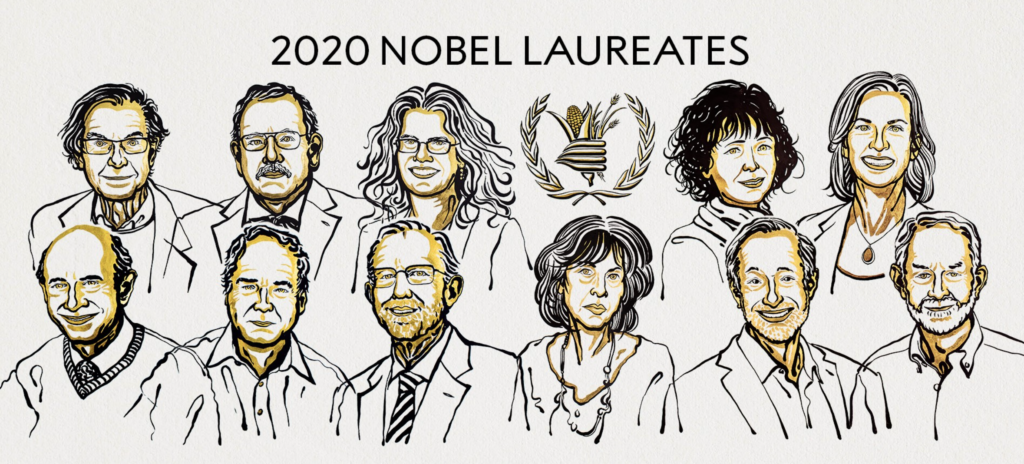
History was made this month when a UC Berkeley biochemist won the Nobel Prize in Chemistry, together with a French-born Berlin-based microbiologist. It is the first time two women have shared the prize, given out by The Royal Swedish Academy Of Sciences. The official documentation for the award in Chemistry states that it was given to Doctors Jennifer A. Doudna and Emmanuelle Charpentier for their work developing a method for genome editing.
Claes Gustafsson is the chair of Nobel Chemistry Committee and says that the CRISPR/Cas9 ‘genetic scissors’ the pair developed is game-changing. “There is enormous power in this genetic tool, which affects us all. It has not only revolutionized basic science but also resulted in innovative crops and will lead to ground-breaking new medical treatments,” Gustafsson wrote when awarding the prize to Doudna and Charpentier.
The CRISPR/Cas9 breakthrough is described as a tool for rewriting the code of life, facilitating researchers to alter the DNA of animals, plants, and organisms with extremely high precision. “This technology has had a revolutionary impact on the life sciences, is contributing to new cancer therapies and may make the dream of curing inherited diseases come true,” the Nobel Prize website states.
Emmanuelle Charpentier published her initial work on CRISPR/Cas9 in 2011. She was investigating bacteria when she came across an unknown molecule. Later that year, Charpentier teamed up with UC Berkeley’s Jennifer Doudna, an expert in RNA, and began looking further into the possibility of disarming viruses by cleaving their DNA. The two collaborated and were successful in “recreating the bacteria’s genetic scissors in a test tube and simplifying the scissors’ molecular components so they were easier to use.”
The Royal Swedish Academy Of Sciences described the reprogramming of genetic scissors as an epoch-making experiment. “In their natural form, the scissors recognize DNA from viruses, but Charpentier and Doudna proved that they could be controlled so that they can cut any DNA molecule at a predetermined site. Where the DNA is cut it is then easy to rewrite the code of life.”
Doudna is a Professor in the Departments of Chemistry and of Molecular and Cell Biology as well as an Investigator at the Howard Hughes Medical Institute. She is an expert in the structure and mechanism of ribozymes (enzymatic RNA molecules) and RNA-protein complexes. Her more recent research focuses on ‘understanding how RNA molecules control gene expression in bacteria and eukaryotic cells, through CRISPR-Cas9 and RNA-mediated mechanisms, respectively.‘ According to her bio, Doudna was elected into the American Academy of Arts and Sciences in 2002, the National Academy of Sciences in 2003, and was awarded the 2015 Breakthrough Prize in the Life Sciences.
Two other researchers from UC were also awarded Nobel Prizes this year. UCLA’s Andrea Ghez and Berkeley’s Reinhard Genzel received the Nobel Prize in Physics for their work on a supermassive black hole that is 4-million times the mass of our sun. Their publications aimed to solve the question of what lies at the center of our galaxy. Dr. Ghez is a professor of physics and astronomy at UCLA, and Dr. Genzel is professor emeritus of physics and astronomy at UC Berkeley. Their discovery that an ‘invisible and extremely heavy object governs the orbits of stars at the center of our galaxy’ shared the Nobel Prize in Physics with an Oxford researcher also working on research relating to the black hole.
David Haviland is the chair of the Nobel Committee for Physics and commended the winners for breaking new ground in the study of company and supermassive objects. “These exotic objects still pose many questions that beg for answers and motivate future research,” Haviland said. “Not only questions about their inner structure, but also questions about how to test our theory of gravity under the extreme conditions in the immediate vicinity of a black hole.”
Doctors Ghez and Reinhard used the world’s largest telescopes to make their discoveries. They developed methods to see through the huge clouds of interstellar gas and dust to the centre of the Milky Way, according to The Nobel Prize Physics committee. “Stretching the limits of technology, they refined new techniques to compensate for distortions caused by the Earth’s atmosphere, building unique instruments and committing themselves to long-term research. Their pioneering work has given us the most convincing evidence yet of a supermassive black hole at the centre of the Milky Way.”
